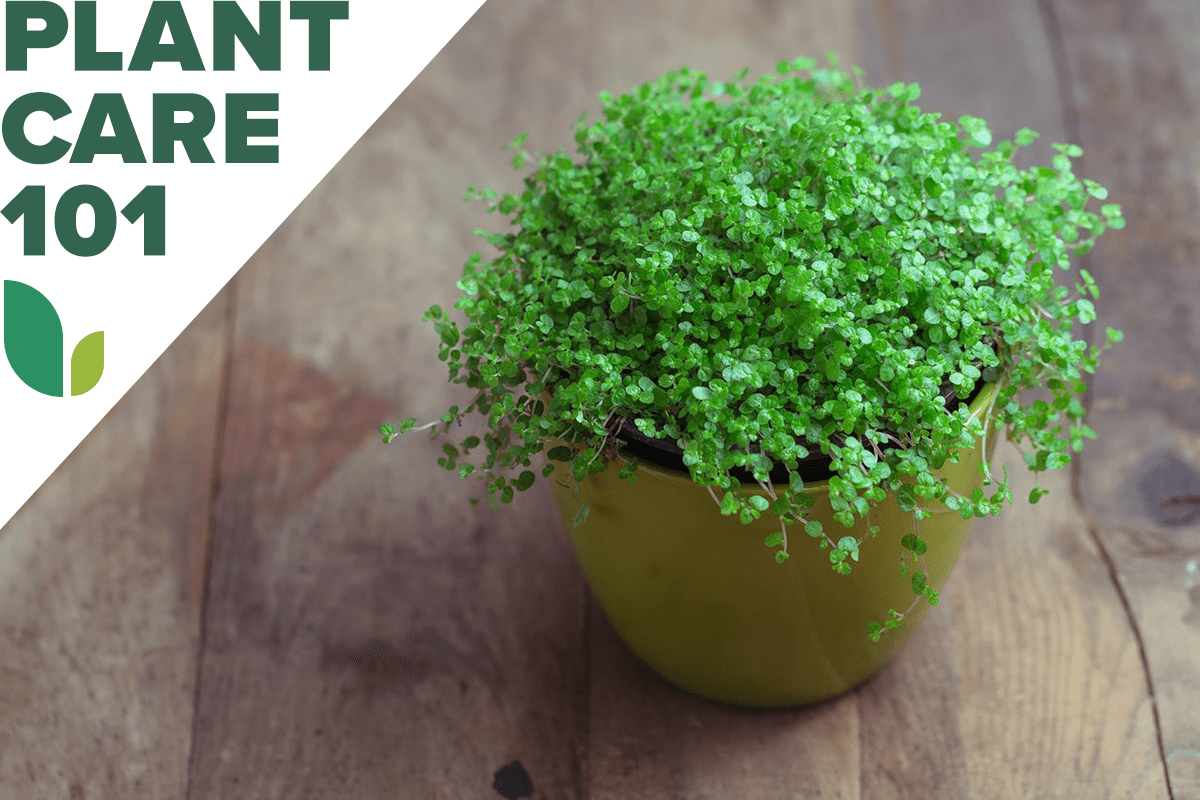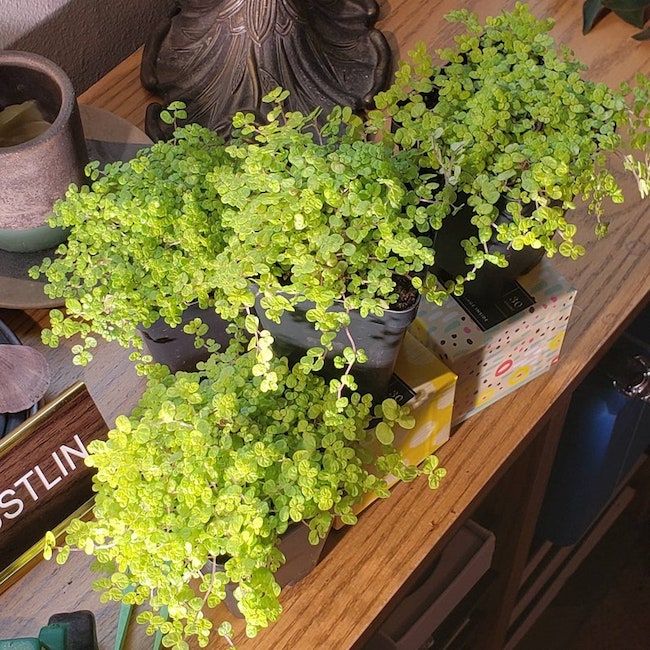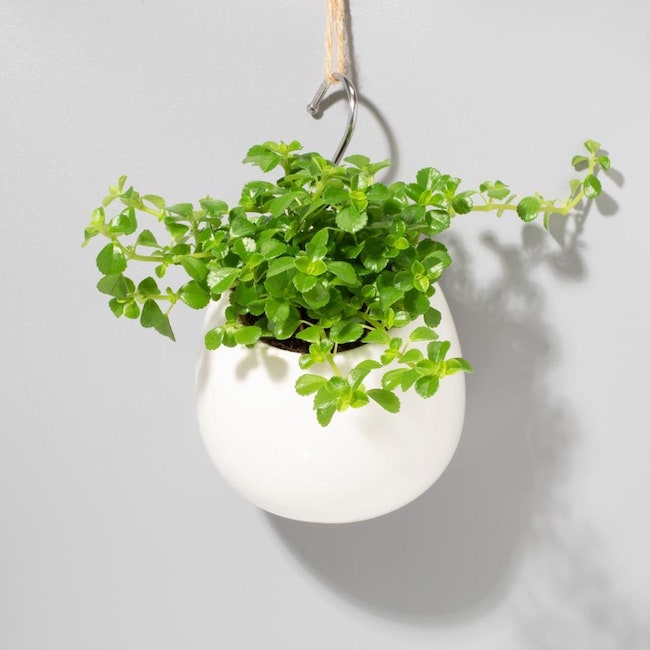

We may earn revenue from the products available on this page and participate in affiliate programs. Learn More ›
With leaves so tiny that it resembles a luxuriant moss, baby’s tears plant (Soleirolia soleirolii), carpets the ground in fairy gardens and terrariums or beneath leggy houseplants and bonsai trees. On its own, the baby tears plant, is indeed, a “weeping” plant that spills spiffily over the sides of hanging baskets or pots.
Though not difficult, baby tears plant care requires attention to watering since this baby will throw a tantrum by wilting dramatically if thirsty. Keep in mind that it is not the same plant as Pilea depressa or Hemianthus callitrichoides, both of which also are called baby’s tears.
Baby’s Tears Plant Care at a Glance
Common Name: Baby’s tears, baby tears, angel’s tears
Scientific Name: Soleirolia soleirolii
Soil: Organic potting soil
Light: Bright, indirect light, morning sun
Water: Medium
Food: Balanced houseplant food
Temperature and Humidity: Cool temperatures, high humidity
Propagation: Division
Safety: Nontoxic
Baby’s Tears Plant Characteristics
Native to the western Mediterranean islands of Corsica and Sardinia and growing only 1 to 5 inches tall, baby’s tears is a creeping plant that roots itself wherever it spreads. Its thread-like green or pink shoots and 1/4-inch leaves cause it to resemble moss, and it often is used outdoors in hot climates as a ground cover for shady spots. Insignificant pinkish-white blooms sometimes appear in late spring or early summer.
Also answering to the intriguing nicknames of mind-your-own-business and peace-in-the-home as well as angel’s tears, Corsican creeper, and many other monikers, this plant reportedly doesn’t stand up well to foot traffic, but will make a green carpet where no one ever treads. Sources disagree on its hardiness, though it probably will remain reliably evergreen only in USDA zones 9 through 11. In frosty areas, it must spend cool months indoors.
Types of Baby’s Tears
- S. soleirolii ‘Aurea’: This cultivar offers yellow-green, rather than green, leaves.
- S. soleirolii ‘Golden Queen’: This type also glows more golden than the typical green variety.
- S. soleirolii ‘Argentea’: Speaking of precious metals, the version of baby’s tears with white-edged leaves also is called Silver Queen or Variegata.
RELATED: 10 Houseplants You Can Propagate the Fastest for an Ever-Expanding Indoor Garden

Selecting Soil for Baby’s Tears Plants
Growing most luxuriantly in humus-rich, well-drained ground, baby’s tears will appreciate an organic potting soil. However, you might want to add one part of coarse builder’s sand to three parts of the potting soil to make sure the soil drains rapidly. Since this baby pot plant requires consistent moisture to keep it happy, the sand should ensure that its fine stems don’t rot in the process.
Because they tend to cascade over the edges of their containers, you’ll want to place baby tear plants in a hanging basket or trim back the delicate “tresses” before they reach a pot’s saucer. A wide, shallow pot with drainage holes works best for this creeper. Be sure you don’t confuse it with the aquarium plant also called baby’s tears, since S. soleirolii is not one of the indoor plants that grow in water.
The Right Light
Outdoors, baby’s tears reportedly will tolerate full sun in cool coastal climates but might burn under too many rays in hotter areas. Therefore, it most often is grown in partial shade or shade.
Indoors, that would translate to either a position in bright, indirect light or on an east- or west-facing windowsill where the baby’s tears receive sun for only part of the day. It also could serve as a ground cover to a larger plant in a south-facing window, provided it is at least partially shaded by that plant’s foliage. Should its green color begin to look bleached, move it to a less bright position.
Related: 10 Dish Garden Ideas to Bring Life to Your Indoor and Outdoor Spaces
Watering Baby’s Tears
In spring and summer, keep this plant’s soil lightly moist at all times. As the days shorten from fall into winter, cut back on watering a bit to prevent root rot, but never allow the soil to dry out completely.
Because overhead watering can mat down the foliage, you might want to water your plant from beneath. To do that, place water in the pot’s saucer and allow it to be drawn up through the pot’s drainage holes into the soil. Add more water as necessary until the surface of the soil feels damp before pouring out any excess water remaining in the saucer. If the soil feels soggy instead of just damp, remove the pot from its saucer and place that pot in a sink until the excess water drains away.
Fertilizing Baby’s Tears Plants
Feed your baby once a month during spring and summer with a balanced houseplant fertilizer such as 20-20-20, used at half the strength recommended on the label. During autumn and winter, avoid feeding the plant, since growth often slows to a crawl during those seasons.
This baby moves by creeping, and if its crawl still seems to be a fast one, you may just want to reduce how often you fertilize the plant instead. Resume the monthly feeding in spring and never fertilize at a time when the soil is completely dry, since that can burn the roots.

Setting the Temperature and Humidity
This plant likes to keep its cool and would prefer daytime temperatures between 60 and 65 degrees Fahrenheit and between 50 and 55 degrees at night. But it usually will tolerate normal household temperatures and humidity.
However, if you wish to keep your baby’s tears plant as happy as possible, place it in your coolest room on top of a humidity tray. (That means a tray filled with gravel that always contains a little water at the bottom, with the water kept shallow enough that it doesn’t touch the pot). There, you may also want to mist the plant at least once a day, using rainwater or spring water to avoid hard water stains.
Propagating Baby’s Tears
Because this plant’s stems root at the nodes as they spread, it propagates itself. Therefore, you need only divide it to make new babies, preferably in spring when it is in its most growing mood.
At that time, you simply can remove the plant from its pot and use a sharp knife to slice through it vertically, dividing it into however many pieces you want to make and giving each piece its own pot of organic potting mix. It usually is a good idea to keep any newly divided plants out of direct sun for a few days until they recover from their “surgery.”
Safety Considerations
Nontoxic to pets, the baby’s tears plant is, in fact, sometimes sold as tortoise food. And at least one blogger reports consuming it in salads that usually would call for watercress. However, there isn’t enough information on its edibility to humans for that sort of recommendation.
Therefore, the plant’s chief danger seems to be that it can become quite invasive in climates where it is hardy, so much so that it sometimes is dubbed the Corsican curse! If you move your plant outdoors for the summer, position it where it isn’t likely to escape and root itself into the landscape.

Potential Pests and Diseases
Since this plant seldom suffers from insect pests, browning or yellowing foliage can usually be attributed to overwatering or underwatering. Brittle leaves result from too little water while yellow lower leaves might indicate too much moisture rotting the roots. A bleached look to the foliage can indicate too much direct light.
Should the plant be severely dehydrated, water it well and move it away from sunlight to an area where it receives only bright, indirect light. You might also want to place it inside a perforated plastic bag for about a month to raise the humidity around it until it “breaks out in tears” again!
If you conclude the problem is root rot instead, remove the plant from its pot. Using a sharp knife or pruning shears, cut out any sections that are obviously rotted—brown and mushy—and repot the plant in fresh soil. Then attempt to give it more light and less water than it received before.
RELATED: 14 of the Fastest-Growing Houseplants for a Nearly Instant Indoor Garden
FAQs About Baby’s Tears Plant Care
For more pointers on raising a happy, healthy baby, check out some of our quick answers on baby tears care below. Should you have additional time to give to your “infant’s” health, you also can find more extensive information above that will have your plant “bursting into tears” in no time!
Give it a position in bright, indirect light or partial sunlight and never allow its soil to dry out completely.
No. They thrive either in bright, indirect light or partial sunlight.
Water the plant enough to keep its soil lightly moist at all times but never soggy.
The most common killers of baby tears plants are either underwatering or overwatering.
Looking for more low-light plants? Check out our guides on caring for Boston fern, polka dot plant, and snake plant.
